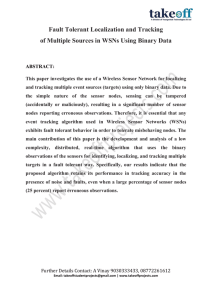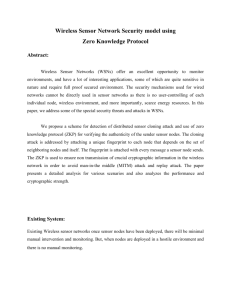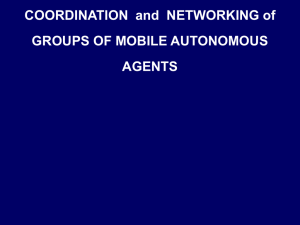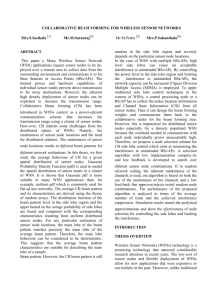Abstract
advertisement
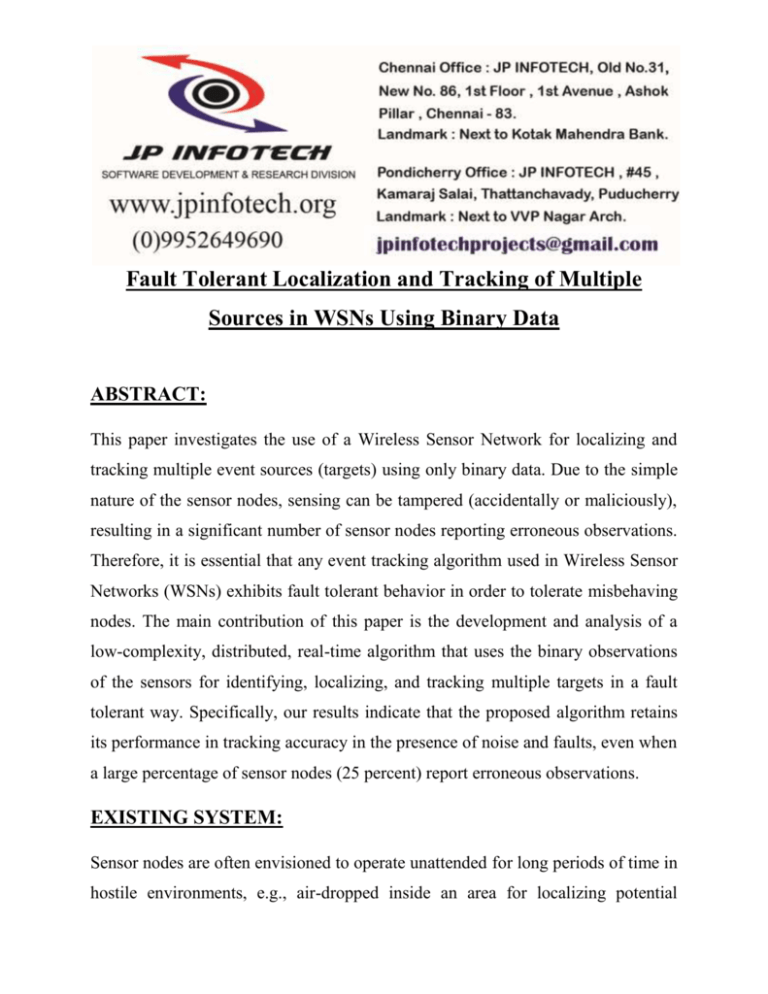
Fault Tolerant Localization and Tracking of Multiple Sources in WSNs Using Binary Data ABSTRACT: This paper investigates the use of a Wireless Sensor Network for localizing and tracking multiple event sources (targets) using only binary data. Due to the simple nature of the sensor nodes, sensing can be tampered (accidentally or maliciously), resulting in a significant number of sensor nodes reporting erroneous observations. Therefore, it is essential that any event tracking algorithm used in Wireless Sensor Networks (WSNs) exhibits fault tolerant behavior in order to tolerate misbehaving nodes. The main contribution of this paper is the development and analysis of a low-complexity, distributed, real-time algorithm that uses the binary observations of the sensors for identifying, localizing, and tracking multiple targets in a fault tolerant way. Specifically, our results indicate that the proposed algorithm retains its performance in tracking accuracy in the presence of noise and faults, even when a large percentage of sensor nodes (25 percent) report erroneous observations. EXISTING SYSTEM: Sensor nodes are often envisioned to operate unattended for long periods of time in hostile environments, e.g., air-dropped inside an area for localizing potential targets and intruders. From a security point of view, there is an increased probability that the sensor readings are affected by a malicious attacker. For instance, the authors present a scenario with malicious actuator nodes deployed to perturb or distort the readings of neighboring sensor nodes within their actuation radius. In addition, sensor nodes can provide erroneous observations for a variety of other reasons: noise, energy depletion, and environmental harsh conditions of operation and software problems. DISADVANTAGES OF EXISTING SYSTEM: In addition, sensor nodes can provide erroneous observations for a variety of other reasons: noise, energy depletion, environmental harsh conditions of operation and software problems. For example, the authors in report situations where a node would constantly report the presence of an event (false positive) when its processing board was overheated, or scenarios in which sensor nodes exhibited unexpected behavior due to soft-ware bugs that were not detected. PROPOSED SYSTEM: Wireless sensor networks (WSNs) have been proposed for monitoring large areas against the presence of event sources. The events can be intruders, enemy vehicles, pollutant sources or fires depending on the application. In all situations, each event source emits a signal or sub-stance that attenuates inside the area under observation and is measured by some of the sensor nodes based on their location relative to the events. In this paper, we develop a fault tolerant localization and tracking algorithm for multiple event sources in WSNs using only binary sensor observations. The proposed algorithm, FTLT (Fault Tolerant Localization and Tracking), has the following three main phases: (i) Identification, (ii) Localization, and (iii) Smoothing. ADVANTAGES OF PROPOSED SYSTEM: The FTLT algorithm, which constitutes the main contribution of this work, features low complexity, distributed implementation, real-time application, and fault tolerance in all three phases of its implementation. The algorithms used in both the Identification and the Localization phase require only simple operations (i.e., additions of ±1). Furthermore, the Kalman filter used in the Smoothing phase was found to be the most efficient tracking method in terms of memory and computation out of the different Bayes filters tested; however, we point out that for certain applications (e.g., maneuvering targets), other filtering techniques may provide more accurate tracking at the expense of computational complexity. MODULES: 1. Identification 2. Localization 3. Smoothing MODULES DESCSRIPTION: Identification Phase: In the Identification phase, all alarmed sensor nodes broadcast their status in their own neighborhood. Then, based on the received information and using a distributed leader election protocol a subset of the alarmed sensor nodes are selfappointed as leaders. After the first phase, the number of elected leaders should correspond to the number of sources present in the field. Localization Phase: In the Localization phase, each leader runs d SNAP (distributed Subtract on Negative observation and Add on Positive) to determine the location of the source by only contacting the sensor nodes in its own neighborhood that are relevant to the estimation problem. Smoothing phase: The location estimates are further refined in the Smoothing phase, where each leader uses a smoothing algorithm to better approximate the path of the source and in order to predict the next leader responsible for tracking it. SYSTEM REQUIREMENTS: HARDWARE REQUIREMENTS: System : Pentium IV 2.4 GHz. Hard Disk : 40 GB. Floppy Drive : 1.44 Mb. Monitor : 15 VGA Colour. Mouse : Logitech. Ram : 512 Mb. SOFTWARE REQUIREMENTS: Operating system : Windows XP/7. Coding Language : C#.net Tool : Visual Studio 2010 Database : SQL SERVER 2008 ] REFERENCE: Michalis P. Michaelides,Member, IEEE, Christos Laoudias,Student Member, IEEE, and Christos G. Panayiotou,Senior Member, IEEE “Fault Tolerant Localization and Tracking of Multiple Sources in WSNs Using Binary Data”IEEE TRANSACTIONS ON MOBILE COMPUTING, VOL. 13, NO. 6, JUNE 2014.
